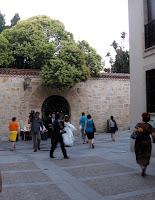
I have a love-hate relationship with shopping. On the one hand, I passionately hate shopping malls, airport concourse shops, department stores, and other sterile environments that are built to artificially recreate a natural setting in which small shops have gradually aggregated in one part of town, all within walking distance of one another. To me, shopping malls are comparable to a Disneyland attempt to recreate “Paris” or “Italy” or “Asia” - a feeble attempt to create an impression of something that should be enjoyed in reality, not reproduction. On the other hand, I love street fairs, markets, and shopping in the city. In fact, under the right conditions, I can be a real binge shopper. My love of city shopping was brought home to me when I was in Salamanca, where there are several main all-pedestrian commercial streets uninterrupted by parking lots or any of the other scourges of auto-based design. Shops are not organized into predictable categories plus a "food court". Sure, there are the clones, the H&Ms and Zaras and Mangos, but there are also the sidewalk cafés, the street vendors, and the small hole-in-the-wall shops where things are unique or handmade, and often somewhat cheaper than the equivalent quality items in the US. There’s also the rastro (Sunday flea market), which is fun to check out once in a while even though 90% of the merchandise is appallingly shoddy junk made in China.
 One afternoon I went on a shopping extravaganza and came home with two new pairs of sandals (Spanish shoes are the best, second only to Italian ones!), a top with a sort of an art-deco beaded theme, two wide knitted headbands of the sort that I like to wear on bad hair days, two pairs of earrings - one pair of chunky silver hoops and another pair made from leather and Greek coins - and a gorgeous silver and mother-of-pearl necklace that M bought me for my birthday. Actually, my birthday’s not till the end of September (I’m a Libra, for whatever that’s worth), but why not celebrate early?
One afternoon I went on a shopping extravaganza and came home with two new pairs of sandals (Spanish shoes are the best, second only to Italian ones!), a top with a sort of an art-deco beaded theme, two wide knitted headbands of the sort that I like to wear on bad hair days, two pairs of earrings - one pair of chunky silver hoops and another pair made from leather and Greek coins - and a gorgeous silver and mother-of-pearl necklace that M bought me for my birthday. Actually, my birthday’s not till the end of September (I’m a Libra, for whatever that’s worth), but why not celebrate early? Perfume-wise, there was nothing remarkable in Salamanca. Sephora and the smaller perfume shops all have the usual selection of commercial and designer fragrances, at about the same prices as the duty-free shops, and significantly more expensive than the online discounters. I noticed that several of the Asian-run discount shops had a rack of incredibly cheap imitations of designer fragrances (a 50 ml bottle of “Chanel No 5” for 2 Euros!). I sniffed a few of them, and they smell every bit as bad as you might expect. Several of the handicraft shops had fragrance oils that were a little more upscale, but still poor quality. I really don’t understand why anyone would buy diluted synthetic lavender fragrance oil when it’s possible to buy the real thing. It was disappointing not to find any exotic fragrance potions and well-kept perfume secrets, but I suppose it’s good that I was able to go for two weeks without buying anything in the fragrance category. Now that I’m back in the land of the shopping mall, I can go without buying any clothing or shoes until I travel again.





























